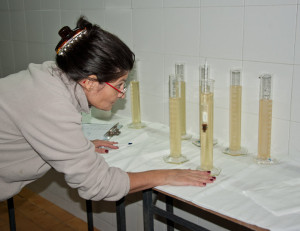How dense is your wine?
October 17th, 2013 | Post Harvest
 Now that most of the seeding of the tanks is done, we have to carefully monitor the progress of the new wine. The way that we do this during fermentation is by measuring the density or specific gravity. The principle is quite simple – as the grape must starts to ferment the amount of sugar in the solution decreases and the amount of ethanol increases – ethanol solution is less dense than sugar solution, so all we have to do is monitor the change using a hydrometer. Two or three times a day (seven days a week) we take a sample of fermenting juice from each tank in a graduated cylinder (see photo). We then allow the hydrometer to float in the liquid and take a reading from the scale etched onto the stem of the instrument. This reading tells us the amount of sugar still remaining, and from this we can calculate the progress of the fermentation process.
Now that most of the seeding of the tanks is done, we have to carefully monitor the progress of the new wine. The way that we do this during fermentation is by measuring the density or specific gravity. The principle is quite simple – as the grape must starts to ferment the amount of sugar in the solution decreases and the amount of ethanol increases – ethanol solution is less dense than sugar solution, so all we have to do is monitor the change using a hydrometer. Two or three times a day (seven days a week) we take a sample of fermenting juice from each tank in a graduated cylinder (see photo). We then allow the hydrometer to float in the liquid and take a reading from the scale etched onto the stem of the instrument. This reading tells us the amount of sugar still remaining, and from this we can calculate the progress of the fermentation process.
There are two main factors that will dictate how quickly the fermentation advances – the strain of yeast used, and of course, the temperature. Some yeasts are very vigorous and will work well in a wide variety of temperatures, whilst others are much more delicate and will only survive during slightly warmer fermentations. As you may well already know, the simple rule is – the warmer the temperature the shorter the fermentation, which is why we are always obsessed by strict temperature control. Here at Castro Martin we prefer a long, slow controlled fermentation, that takes roughly 3 to 4 weeks to complete. Patience is a virtue, and, good things come to those who wait, to coin a couple of well-worn phrases…..
 Now that most of the seeding of the tanks is done, we have to carefully monitor the progress of the new wine. The way that we do this during fermentation is by measuring the density or specific gravity. The principle is quite simple – as the grape must starts to ferment the amount of sugar in the solution decreases and the amount of ethanol increases – ethanol solution is less dense than sugar solution, so all we have to do is monitor the change using a hydrometer. Two or three times a day (seven days a week) we take a sample of fermenting juice from each tank in a graduated cylinder (see photo). We then allow the hydrometer to float in the liquid and take a reading from the scale etched onto the stem of the instrument. This reading tells us the amount of sugar still remaining, and from this we can calculate the progress of the fermentation process.
Now that most of the seeding of the tanks is done, we have to carefully monitor the progress of the new wine. The way that we do this during fermentation is by measuring the density or specific gravity. The principle is quite simple – as the grape must starts to ferment the amount of sugar in the solution decreases and the amount of ethanol increases – ethanol solution is less dense than sugar solution, so all we have to do is monitor the change using a hydrometer. Two or three times a day (seven days a week) we take a sample of fermenting juice from each tank in a graduated cylinder (see photo). We then allow the hydrometer to float in the liquid and take a reading from the scale etched onto the stem of the instrument. This reading tells us the amount of sugar still remaining, and from this we can calculate the progress of the fermentation process.
There are two main factors that will dictate how quickly the fermentation advances – the strain of yeast used, and of course, the temperature. Some yeasts are very vigorous and will work well in a wide variety of temperatures, whilst others are much more delicate and will only survive during slightly warmer fermentations. As you may well already know, the simple rule is – the warmer the temperature the shorter the fermentation, which is why we are always obsessed by strict temperature control. Here at Castro Martin we prefer a long, slow controlled fermentation, that takes roughly 3 to 4 weeks to complete. Patience is a virtue, and, good things come to those who wait, to coin a couple of well-worn phrases…..


